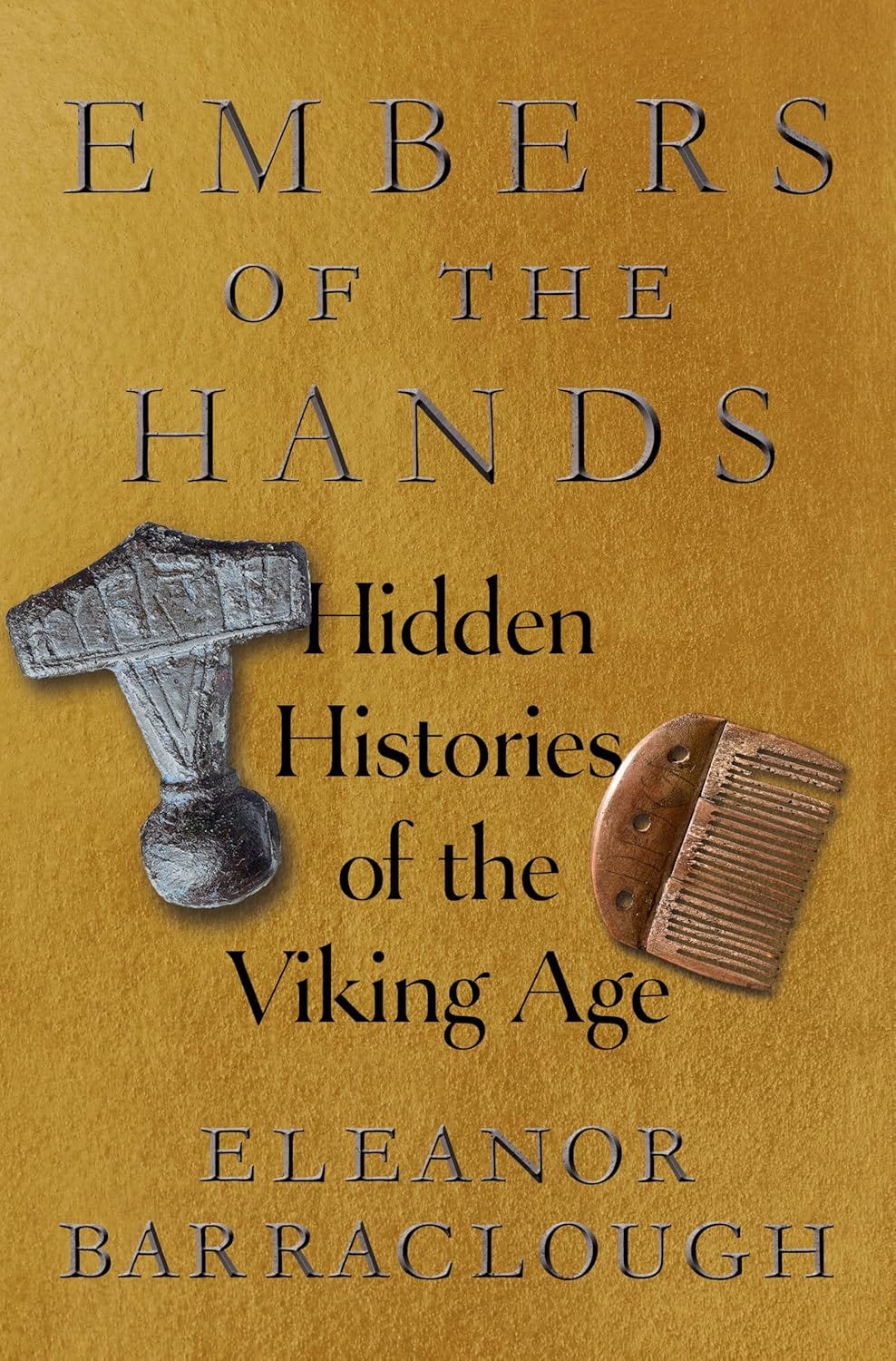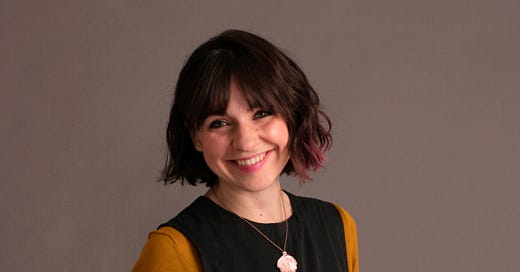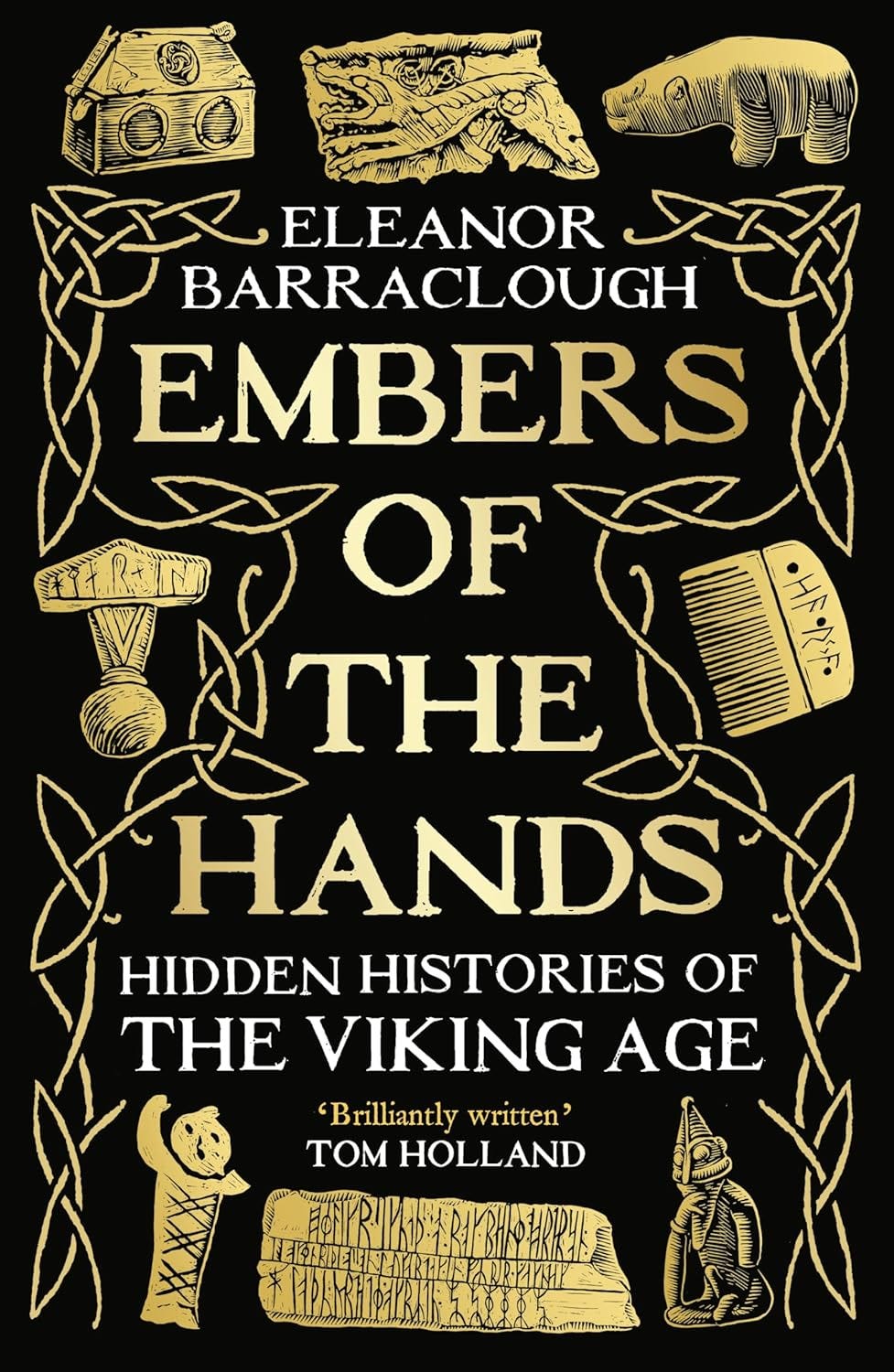Between the Cracks of History: Eleanor Barraclough Illuminates Everyday Life in the Viking Age
In the grand narratives of Viking history, the stories of kings, warriors, and seafaring adventurers have long dominated our understanding of the medieval Norse world. But what of the countless others whose lives shaped this remarkable era? This question lies at the heart of Dr. Eleanor Barraclough's latest work, Embers of the Hands: Hidden Histories of the Viking Age (released in the UK on September 19, 2024, and scheduled to be released in the USA on January 7, 2025), a groundbreaking exploration of ordinary lives in extraordinary times. Recently named by The Times as one of the 21 best history books of 2024, the work represents a significant contribution to our understanding of everyday Viking life.
As a historian who has quite literally traced the footsteps of Viking travelers—from the ruins of Norse settlements in Greenland to the depths of Arctic Scandinavia—Barraclough brings a uniquely immersive perspective to her scholarship. Currently based at Bath Spa University after serving as Associate Professor in Medieval History and Literature at Durham University, Barraclough has built an impressive academic career that includes a Leverhulme Fellowship at the University of Oxford and recognition as a Fellow of both the Royal Historical Society and the Society of Antiquaries. Throughout this journey, she has dedicated herself to making the medieval world accessible to contemporary audiences. Since being selected as a BBC/AHRC New Generation Thinker in 2013, she has become a familiar voice in public discourse about medieval history, bringing academic insights to life through various media platforms.
In Embers of the Hands, Barraclough takes a dramatic departure from her previous work, Beyond the Northlands: Viking Voyages and the Old Norse Sagas (2016). While her earlier book chronicled the tales of far-travelers and saga heroes, her new work turns to those who stood in the wings of history—the women, children, enslaved people, and countless others who, in her words, "fell between the cracks of history." Through careful analysis of everyday objects—from children's teeth marks on chewed tree resin to women's names carved in runic script on loom weights—Barraclough reconstructs a vivid picture of Viking Age society from the ground up.

In the following interview, Barraclough discusses how the constraints of the COVID-19 pandemic unexpectedly shaped her intimate approach to Viking history, explains her creative structuring of the book around themes like 'Love,' 'Travel,' and 'Belief,' and reveals how her adventures in Norse Greenland—including explorations on horseback and by water—informed her understanding of how Viking settlers made homes in the most challenging environments. She also shares insights into her methodology for uncovering the lives of traditionally marginalized groups. She explains why viewing history as a "great flowing river" rather than a series of neat segments has been crucial to her understanding of the Viking Age.
Jonathan Crain: Could you begin by explaining the premise of Embers of the Hands and what you set out to achieve with this book?
Eleanor Barraclough: I wanted to write about the lives of ordinary humans who lived during the Viking Age rather than the larger-than-life headline hitters whose names end up immortalized in sagas, poetry, and annals. In other words, the people who, like most of us in this world, fell between the cracks of history. The challenge was: how to write such a history in a way that weaves together the big global events with the everyday lives, and how to make those everyday lives exciting and compelling to read about? My solution was to focus on the little bits and pieces of their lives that survived down to the present day: everything from children's drawings to runic inscriptions, from musical instruments to the remains of sacrifices to supernatural beings. This meant that I needed to come up with a flexible approach to structure the material: I bookended it with chapters on 'Beginnings' and 'Endings,' and then the rest of the chapters were thematic: 'Love,' 'Travel,' 'Belief,' 'Bodies,' 'Home,' 'Play' and 'Unfreedom.'
Jonathan Crain: Given your extensive work on Iceland and the North Atlantic in Beyond the Northlands, what inspired you to shift focus to the more intimate, everyday histories in Embers of the Hands?
Eleanor Barraclough: That's such a good question. In Beyond the Northlands, my focus was on the far-travelers of the medieval Norse world, the tales and reports that they brought back with them from their adventures, and how these were woven into the Old Norse Icelandic sagas to create stories that straddle the hazy borders between fact and fantasy. Obviously, there were a lot of big names and saga heroes in that book. But even then, I found myself drawn to the historical figures who kept appearing in my peripheral vision, the characters standing in the wings at the edge of the historical stage. The Norse Greenlandic hunters who sheltered over winter on a tiny island far beyond the Arctic Circle and scratched their names in runes. The artist who carved a beautiful figure of a polar bear from walrus ivory but threw it on the rubbish heap when they had finished, perhaps because the polar bear's neck was out of proportion. The seafarers who set off to cross vast stretches of ocean but never made it to the other side. The enslaved people who seemed to be nowhere and yet everywhere in the historical records. The humans who were sick, or old, or young, or disabled, or poor, or just female: in other words pretty much everyone. These were the shadowy historical figures that stuck in my mind long after I finished Beyond the Northlands. So eventually I decided they needed their own history.
Jonathan Crain: Your research is known for being "physically embedded in the topography." How did this approach of exploring Viking ruins and hunting for runic graffiti influence your methodology in writing Embers of the Hands?
Eleanor Barraclough: It was a really interesting one. For Beyond the Northlands, I was able to follow the Viking far-travelers out all over the world, quite literally: I traveled to places such as Greenland, Iceland, Arctic Scandinavia, Rome, and Istanbul. But for Embers of the Hands, the earliest parts of the book were conceived of during the COVID pandemic and while I was stuck at home during long lockdowns with a 1-year-old and a newborn. So there was definitely no travelling, which wasn't easy for someone who, as you say, likes to research in the field. As the world opened up again, I definitely found ways to get out into the world again as this book came together– we took the two babes on a research road trip across Europe, through the Netherlands and Germany, and all the way to Denmark, for example. And all the time I was writing, I was drawing on all the research trips to weird and wild places that I'd been to in the past. Even so, my hope is that there's an intimacy to Embers that comes from how so much of it was conceived of and written: a sense of getting close to the lives of individuals and the minutiae of their experiences, emotions, and beliefs.
Jonathan Crain: As someone who has studied Old Norse language and literature extensively, how did your linguistic background shape your interpretation of runic inscriptions and other textual sources in the book?
Eleanor Barraclough: I think what really helps is understanding how complex these textual sources are as historical evidence in terms of how they came to be written down and the long oral storytelling traditions that underpin them. When you start learning the Old Norse language and studying its literature, it doesn't take long before you realise how complex the manuscript traditions are, how many versions of a saga or poem might survive, or how many sagas or poems didn't survive at all, then it can start to feel rather overwhelming. There comes a point where you have to take a step back and, take a deep breath, and meet these historical sources on their own terms. Then, suddenly, they start to open up to us. It's a case of working out what sort of questions can we ask of them and what sort of answers can they give us. What can they tell us about the broader culture in which they were created and embedded, about how people thought about the world and their place within it?
Jonathan Crain: Having worked on specific geographical areas like Iceland and Greenland, how did this regional expertise inform your broader understanding of Viking Age society as presented in Embers of the Hands?
Eleanor Barraclough: I found that there was always a balance to be struck between the macro and micro scales of history. This applies to both different regions of the Viking Age world and also different time periods within those centuries. I've always had a particular love for Norse Greenland – I spent a lot of time researching out there, exploring the ruins of the Norse settlements on the west coast. There are no real road systems beyond the modern towns and villages, so I had to get creative. The first year, I traveled on the back of an Icelandic horse whose name translates as 'he whose eyes pop out of his head when he sees a beautiful woman walking past.' I was in the company of a very badass horsewoman: if she thought I was mad because of what I was doing, she kept it to herself. The next year, I did most of my exploring by water, with two extraordinary caribou hunters as my guides through the deep fjords. The wonderful thing about Norse Greenland is that so much of it survives: above ground, there are the ruined farmsteads and churches; below ground, lots of organic material is preserved (such as clothing) because of the permafrost. So when it came to Embers, I decided to make Norse Greenland the focus of my chapter on 'Home' – partly because so much domestic material survives and partly because I'm fascinated by the question of how the Norse settlers made a home in these uninhabited, barely farmable lands on the margins of the world they knew.
Jonathan Crain: The book's title comes from a Viking Age kenning. Could you explain the significance of this choice and how it relates to your methodology of using tangible remnants to tell these stories?
Eleanor Barraclough: 'Embers of the Hands' is a kenning – kennings are a sort of little cryptic crossword clues tucked up in Old Norse poetry, which need to be unraveled and interpreted before we can understand what the poet is telling us. In this case, the original meaning of 'embers of the hands' was 'gold' or perhaps 'silver' – a precious metal glowing and shimmering like fire on the hand or arm of the one who possessed it. The original kenning was composed by an 11th-century skald called Thorarin Skeggjason, who was the court poet of King Harald Hardrada of Norway. So I quite liked the idea of repurposing, even subverting, a kenning initially composed for a Viking Age monarch. I wanted to think about a different sort of embers, no less precious, the personal fragments and everyday detritus that remain of lives long past. And this sense of everyday, ordinary preciousness was really at the heart of what I was trying to achieve with this book.
Jonathan Crain: You've managed to illuminate the lives of traditionally overlooked groups - women, children, and enslaved people. What were the biggest challenges in reconstructing these histories given the limitations of available sources?
Eleanor Barraclough: The biggest challenge was finding the evidence: those 'embers of the hands' of the title, the little bits and pieces of their lives that still survive today. But the more you look, the more you realize that these people were there all along, hiding in plain sight, represented by exactly the sorts of bits and pieces of physical evidence that often get overlooked in the more traditional historical narratives of the Viking Age—for example, weights on looms for making textiles with women's names carved in runes. Or children's teeth marks on a lump of chewed tree resin. Finding evidence for enslaved people was particularly challenging, other than the few occasions where, unfortunately, metal shackles survive, or, even worse, the bodies of individuals who seem to have been killed violently: sacrificed to join their master in the next world. There are some incredible researchers working to uncover and interpret evidence for these marginalized people of the past. History is never written in a vacuum: in my case, I see my writing as part of a global conversation with an extraordinary network of historians, archaeologists, philologists, palaeographers, and so on. Part of the reason that my acknowledgements are several pages long is because so many of them were kind enough to share their research, answer my questions and help hone my ideas.
Jonathan Crain: The book emphasizes the interconnectedness of historical periods, particularly through what you call the "ribbon of events" stretching back to the Roman Empire. How did this perspective shape your research methodology?
Eleanor Barraclough: This sense of historical interconnectedness was very important to me in how I wanted to tell the story of the Viking Age. In Embers of the Hands, I write that we tend to learn history at school as though it's a series of canal locks: the dates neatly segmented by the deaths of important rulers or major events. But history is more like a great flowing river that branches off and rejoins unexpectedly, unpredictable and wild, without clear beginnings or endings. We're all bumping along in these historical currents, and we don't always know where we are or where the river is taking us. With hindsight, it's always tempting to look back at the past and think, 'Well, of course, this is where things were going to end up' or 'That story was never going to end any other way.' But I wanted to challenge that idea: it's too neat, too artificial, too easy. History is always messier than that. Often, there are a lot of grey areas and blank spaces. Fresh information comes to light, old ideas are challenged, and new questions and perspectives emerge. For me, that's part of the joy and excitement of history and the Viking Age most of all.
Throughout our conversation, Barraclough returns to the idea that history is "more like a great flowing river that branches off and rejoins unexpectedly, unpredictable and wild, without clear beginnings or endings." This perspective fundamentally shapes "Embers of the Hands," allowing her to weave together the grand events of the Viking Age with intimate glimpses of everyday life. The result is a work that challenges traditional historical narratives while remaining deeply accessible to general readers.
The book's approach to material culture proves particularly revelatory. As Barraclough explains, these overlooked people were "there all along, hiding in plain sight, represented by exactly the sorts of bits and pieces of physical evidence that often get overlooked in the more traditional historical narratives of the Viking Age." From loom weights bearing women's names to the preserved clothing found in Greenland's permafrost, each artifact opens a window into the lives of those who, as she puts it, were "sick, or old, or young, or disabled, or poor, or just female: in other words pretty much everyone."
"Embers of the Hands" arrives at a moment when historians are increasingly turning their attention to marginalized voices in the historical record. Barraclough demonstrates how much we can learn about a society by studying its everyday objects through her innovative use of material culture and her ability to draw meaningful connections between artifacts and lived experiences. As she writes, these fragments become "no less precious" than the gold and silver celebrated in medieval poetry—they are the tangible remains of lives that, though long past, continue to illuminate our understanding of the human experience.
For more on Dr. Barraclough and her fascinating work, visit her website.
You can purchase Embers of the Hands: Hidden Histories of the Viking Age in the UK (Profile Books, September 19, 2024) from Blackwells, Waterstones, and Amazon. In the USA (W. W. Norton & Company, January 7, 2025), it is available from Amazon or Barnes & Noble.





I was struck (and moved) by the mention of “children's teeth marks on a lump of chewed tree resin”—it’s so startling and touching to be reminded of what connects us across centuries (like teething babies!).